
Ram pressure is a pressure exerted on a body moving through a fluid medium, caused by relative bulk motion of the fluid rather than random thermal motion. It causes a drag force to be exerted on the body. Ram pressure is given in tensor form as

NGC 4309 is a lenticular galaxy located about 55 million light-years away in the constellation Virgo. The galaxy was discovered by astronomer Christian Peters in 1881 and is a member of the Virgo Cluster.

A jellyfish galaxy is a type of galaxy found in galaxy clusters. They are characterised by ram pressure stripping of gas from the affected galaxy by the intracluster medium, triggering starbursts along a tail of gas.

NGC 4457 is an intermediate spiral galaxy located about 55 million light-years away in the constellation of Virgo. It is also classified as a LINER galaxy, a class of active galaxy defined by their spectral line emissions. NGC 4457 Is inclined by about 33°. It was discovered by astronomer William Herschel on February 23, 1784. Despite being listed in the Virgo Cluster Catalog as VCC 1145, NGC 4457 is a member of the Virgo II Groups which form an extension of the Virgo cluster.
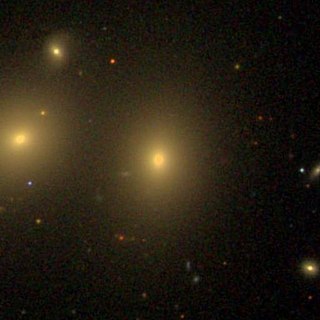
NGC 4061 is an elliptical galaxy located 310 light-years away in the constellation Coma Berenices. It was discovered by astronomer William Herschel on April 27, 1785. It was rediscovered by John Herschel on April 29, 1832. It is listed both as NGC 4061 and NGC 4055. NGC 4061 is a member of the NGC 4065 Group and forms an interacting pair with its companion, NGC 4065 as evidenced by distortions in their optical isophotes.
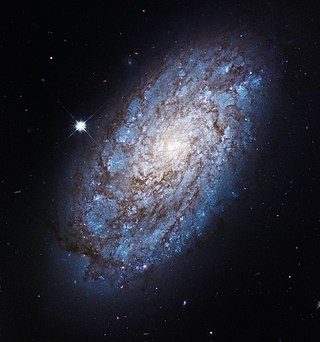
NGC 4298 is a flocculent spiral galaxy located about 53 million light-years away in the constellation Coma Berenices. The galaxy was discovered by astronomer William Herschel on April 8, 1784 and is a member of the Virgo Cluster.

NGC 4307 is an edge-on spiral galaxy located about 65 million light-years away in the constellation Virgo. It was discovered by astronomer Christian Peters in 1881 and is a member of the Virgo Cluster. It is also a LINER galaxy.
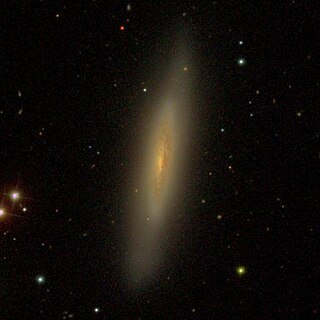
NGC 4312 is an edge-on unbarred spiral galaxy located about 55 million light-years away in the constellation Coma Berenices. It was discovered by astronomer William Herschel on January 14, 1787. NGC 4312 is a member of the Virgo Cluster and is a LINER galaxy.

NGC 4313 is an edge-on spiral galaxy located about 50 million light-years away in the constellation Virgo. It was discovered by astronomer William Herschel on March 15, 1784. NGC 4313 is a member of the Virgo Cluster and is classified as LINER and as a Seyfert galaxy.

NGC 7720 is an elliptical galaxy located in the constellation Pegasus. It is located at a distance of about 380 million light years from Earth, which, given its apparent dimensions, means that NGC 7720 is about 180,000 light years across. NGC 7720 is the main galaxy of Abell 2634 galaxy cluster and is a radio galaxy. It was discovered by William Herschel on September 10, 1784.

IC 4141 is a spiral galaxy in the constellation of Coma Berenices. The galaxy is located 900 million light-years away from Earth. Founded in 1904 by German astronomer Max Wolf, it measures 255,000 light-years across in diameter. With a radial velocity of 19,000 kilometers per second, it is slowly drifting from the Solar System.
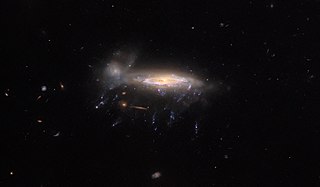
PGC 29820 is a spiral galaxy located 600 million light-years away from the Solar System in the Sextans constellation. The galaxy is about 120,000 light-years in diameter and is a member of Abell 957, a low-mass galaxy cluster.

PGC 65543, is a spiral galaxy, with extensive star forming regions, located in Indus. It is 650 million light-years away from the Solar System and approximately measuring 90,000 light-years in diameter. The tidal interactions from certain galaxies which PGC 65543 is moving towards to, have caused it to get distorted. Its star-forming gas and dust are dynamically stripped by ram-pressure and formed into tendrils that stretch outwards, thus gives an appearance of a jellyfish galaxy.
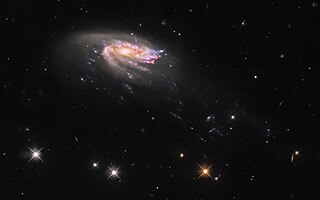
PGC 1228197 known as WINGS J211347.41+022834.9 and JO206, is a large spiral galaxy located 700 million light-years away towards the constellation of Aquarius. The galaxy is estimated to be at least 160,000 light-years in diameter, making it somehow bigger than the Milky Way. With a radial velocity of 15,226 kilometers per second, it is slowly drifting away.
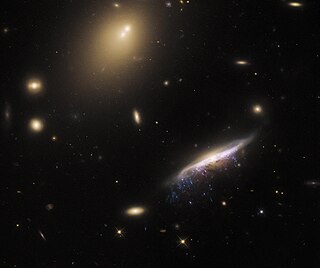
IC 5337 or JW100, is a spiral galaxy located 800 million light-years away from the Solar System in the constellation of Pegasus.

4C +09.17 is a quasar located in the constellation Orion. With a redshift of 2.108300, the object is located 10.6 billion light years from Earth and presents an extragalactic astrophysical jet morphology.

Abell 2219 BCG, also known as PGC 2285869, is a massive type-cD elliptical galaxy residing as the brightest cluster galaxy (BCG) in the Abell 2219 galaxy cluster located in constellation Hercules. At the redshift of 0.224, the galaxy is around 2.7 billion light-years from Earth.

Abell 1942 BCG, also known as PGC 1256558, is a massive elliptical galaxy of type-cD residing as the brightest cluster galaxy of the Abell 1942 galaxy cluster, located in the constellation Virgo. With a redshift of 0.224, the galaxy is located nearly 2.7 billion light-years away from Earth.

Abell 697 BCG, also known as PGC 2079433, is a massive type-cD elliptical galaxy residing as the brightest cluster galaxy in Abell 697 galaxy cluster. It is located in the constellation of Lynx and has a redshift of 0.28, meaning the galaxy is located 3.5 billion light-years away from Earth.

Abell 68 is massive and rich galaxy cluster located in the constellation of Pisces with a projected co-moving distance of approximately 1124.6 Mpc or 3.668 billion light-years away from Earth. The cluster is especially notable for its gravitational lensing and was first discovered by George O. Abell in 1958.




















